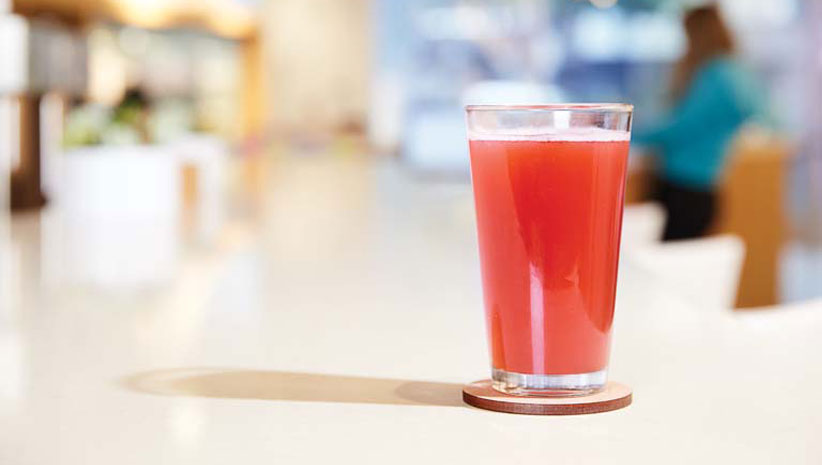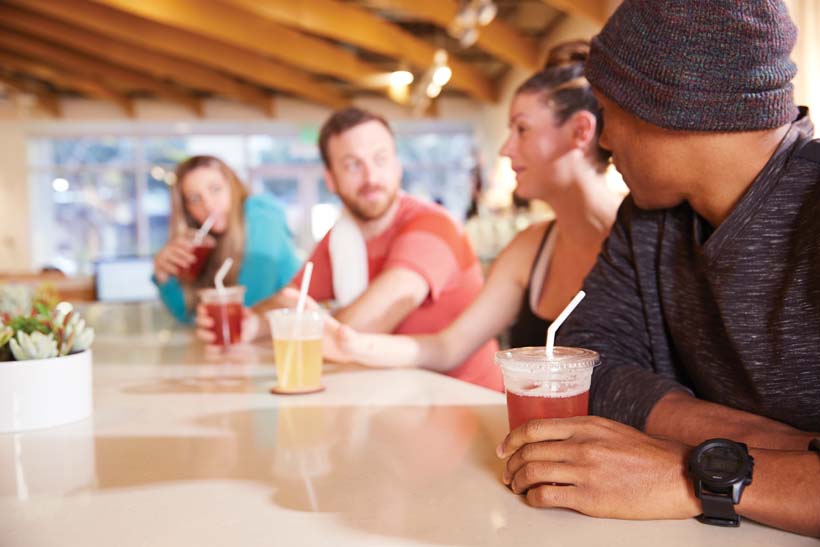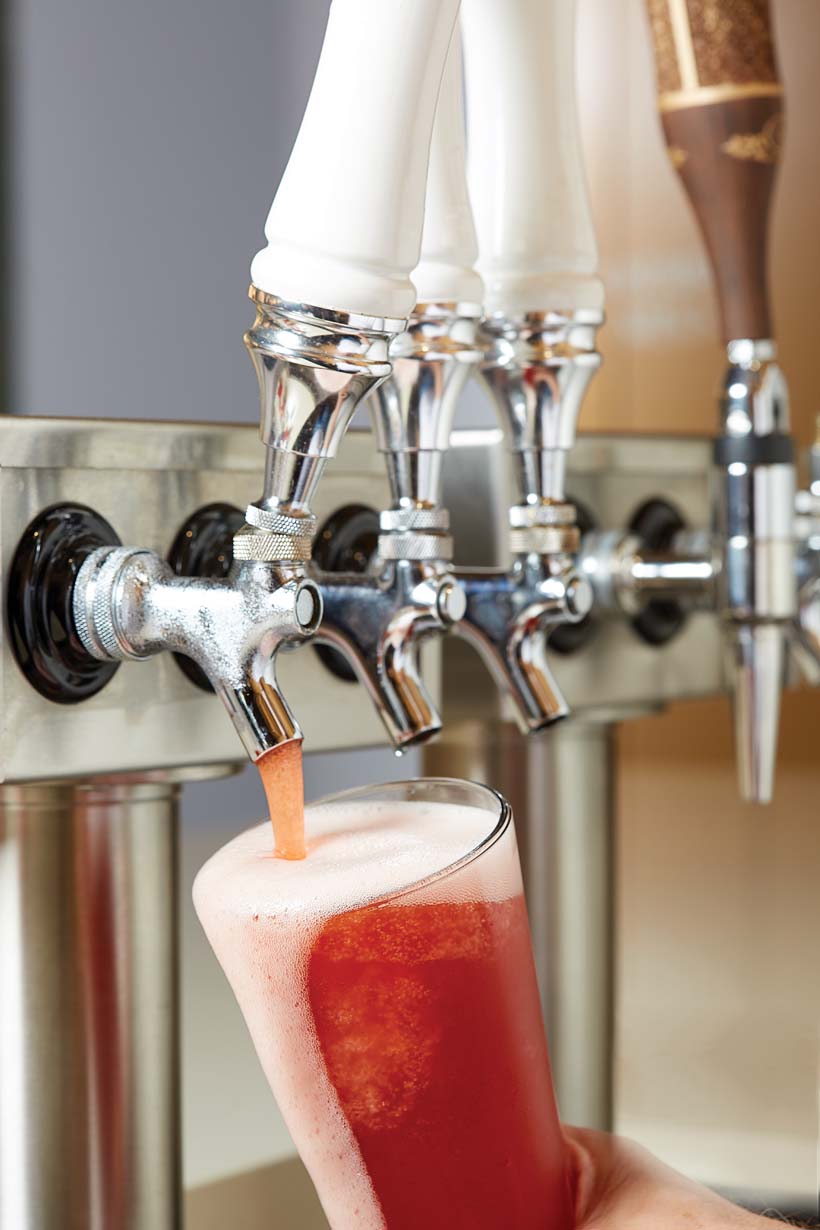
GT’s Synergy Kombucha photographed by Jeff Skeirik at Set and Flow Yoga
The Intel on Kombucha:
How to Brew, How to Buy, and How to Mix
So you visited your friend over the holidays and in their kitchen you saw this strange looking floating alien in a jar of liquid. Are they harboring visitors from another galaxy?
No, they tell you, it’s for making kombucha!
You may have seen those sparkling bottles of brew on the shelves at your local Whole Foods or other stores. You may have observed something that isn’t beer on tap at a restaurant, bar, or even a yoga studio. Or maybe you tasted some when your coworker brought a Mason jar full to the company work affair a few months ago. Whether or now you’ve seen it or tried it, you may wonder: What exactly is kombucha?
Kombucha is a fermented probiotic drink made from sweetened tea. Added to the tea is a SCOBY (Symbiotic Colony of Bacteria and Yeast), which transforms the tea into something some people call the “Elixir of Life”, cheekily said to be able to cure everything from cancer to depression. Kombucha gets its slight effervescence from the yeasts metabolizing the sugar into carbon dioxide, similar to the process that gives champagne its fizz. This makes kombucha delightfully refreshing.
Kombucha is easy to make and has numerous health benefits. The hallmark of kombucha is the rich colonies of microbes grown as a result of the interaction between the SCOBY and the tea—known as probiotics. Probiotics are live bacteria and yeasts that are positive components of your internal flora, aiding in keeping our gut healthy by assisting in digestion and absorption. Probiotics can also be found in a variety of fermented foods including sauerkraut and yogurt.

Yoga teachers and students drinking kombucha at Set and Flow Yoga. Photographed by Jeff Skeirik/Rawtographer
Fun Facts about Kombucha
Researchers are unsure if kombucha was created on purpose or by accident. With a liquid base of tea, kombucha is widely suspected to have originated in China, specifically in the Manchurian region around 220 BC.
Tea Kvas, a drink associated with and consumed in Russia, also uses tea as a base, but instead of the SCOBY, a birch tree mushroom called chaga is added to the mix to help turn the tea into a beverage similar to kombucha with a distinctive effervescence and fermented taste.
The sour taste in kombucha comes from the bacterial fermentation of ethanol, a byproduct of yeast fermentation. The bacteria in the SCOBY turns the ethanol into an acid similar in composition to apple cider vinegar with comparable health benefits since a slightly acidic intestinal track prevents opportunistic yeasts like candida or harmful bacteria like E.Coli from growing in greater numbers or where they don’t belong.
The German word for kombucha, teeschwamm, translates to mean “tea fungus.”
Dried SCOBIES can even be used to make clothing: The dried SCOBY has a leather-like texture and has been used by adventurous designers to create jackets, blouses, and even shoes!
SCOBIES are also used as facial masks. The acidity is said to work like a light peel, clearing up your skin and improving its radiance.
There are trace amounts (>0.5%) of alcohol in kombucha. The amount is not enough to get you intoxicated, though if you are sensitive to the effects of alcohol, you might want to be careful in consuming it. For some people who want to make a stronger, adult brew, you could change the ratio of yeasts and bacteria: There is a heavy concentration of yeast present in the bottom of your SCOBY colony (fondly called a hotel by kombucha brewers). When you make your next batch, add some of this sediment to get a bigger kick!
Kombucha is a great substitute for sugary, chemical-laden carbonated drinks. For example, one can of Coca-Cola contains up to 38g of sugar; a bottle or glass of kombucha typically has less than 5g of sugar, and the longer you brew your kombucha, the lower that sugar level will be.
Although it is made from tea, kombucha contains less than 25mg of caffeine. If you are sensitive to caffeine, you can easily reduce this amount by using non-caffeinated herbal teas in your brew. Do not use commercially decaffeinated teas, since they have been treated with chemicals that could potentially inhibit the bacterial and yeast growths in your kombucha.
What to know if you want to brew your own kombucha at home:
How to get or make a SCOBY
There are a few ways you can go about obtaining a SCOBY. You can ask a friend for a piece of theirs along with about a cup of the liquid of the SCOBY hotel: this is a fast and easy way to start with minimal advance preparations. You can order a SCOBY from a website like Cultures for Health that comes with a handy instruction manual, or you could grow one from scratch (takes a bit longer) by purchasing a bottle of raw, unpasteurized kombucha and combining it with a cup of brewed tea that has been cooled to room temperature. Leave this mixture in a warm spot (68-85F), and in about 7-10 days you will see a clear film or blob floating on top. Welcome to the world, baby SCOBY!
How to brew Kombucha
Heat 2-3 cups of filtered water to 180F. Always use filtered water because hard chemicals in regular tap water will inhibit growth of your bacteria and yeasts.
Add 1/2 tablespoon of brewed black tea (or a combination of black and green tea) and
1/4 cup of organic cane sugar. In order to prepare this tea, let the tea steep until cooled to 68-75F.
Strain out the tea leaves into a glass quart jar using a tea strainer or cheesecloth.
Add the SCOBY along with 1/2 cup of your original starter tea to the bath of fresh tea.
Cover the jar with a coffee filter and secure it with a rubber band (keeps out the critters and other contaminants). Allow this mixture to sit undisturbed out of direct sunlight for seven days.
Taste the kombucha: you are looking for a slightly sour flavor and an effervescent tingle on your tongue.
Let the Kombucha ferment for additional days to have a less sweet beverage.
When you have reached your desired sourness, pour the kombucha through a sieve, reserving 1/2 cup for your next batch. If the kombucha at any time taste or smells bad or off, trust your tongue and start over. Better be safe than sick!
At this point in the process, you can now flavor your kombucha with different fruit infusions. Be adventurous and use fresh herbs or whole spices too! Add the desired flavorings, steep for an additional day (also called a second ferment or 2F), strain and place in the fridge.
Brew Kombucha Blends
Ginger Strawberry: 1 inch fresh sliced ginger and 1 cup sliced organic strawberries
Rosemary Peach: a sprig of washed rosemary and a cup of frozen sliced peaches
Lavender Lemon: 1/2 teaspoon of lavender buds and the rind of a lemon
Mango Cardamom: 1 cup mango chunks (fresh or frozen) and 3 whole cardamom pods.
Playing around with tea combinations also gives you the opportunity to create fun and exciting flavors. Try flavorful teas like rooibos or hibiscus to flavor your kombucha, but remember that strong colored teas will stain your SCOBY and impart color to any future batches.

GT’s Trilogy Kombucha from the tap at Set and Flow Yoga Photographed by Jeff Skeirik/Rawtographer
Buying Kombucha
Bustling around with strainers and cheesecloths might not be your “cup of tea,” so here are some things to look for if you are going to buy bottled kombucha in the store:
Look for raw, unpasteurized brands. Pasteurization kills the beneficial bacteria.
Watch out for added sugars. Some commercial brands add extra sugar to the drink to appeal to consumers.
Be adventurous in your choices. Why not try the cantaloupe sage flavor? It’s only one bottle and you can always buy a different one if the flavor is not to your liking
Watch out for foul smells. If the kombucha you bought has a strange or off smell, do not consume it. Although kombucha brewers take utmost care in the production process, pathogens can slip in and make you sick.

Toast with Kombucha Mocktails. Kombucha from the tap at Set and Flow Yoga in Hollywood. Photographed by Jeff Skeirik/Rawtographer
Mocktails
You don’t have to be an expert Mixologist to shake up these fun libations:
Black Berry Mint Fizz
Skip the Champagne and sip on this delightful dry and refreshing bubbly drink while enjoying appetizers.
Ingredients
1/4 cup organic blackberries, fresh or frozen
8 fresh mint leaves, washed
8 oz plain, unflavored kombucha, chilled
8 oz sparkling water or sparking wine, chilled
Instructions
In a glass pitcher, add the berries and mint leaves, and using the back of a wooden spoon, muddle the berries and mint until fragrant and broken down.
Pour the kombucha and sparkling water or wine in the pitcher and stir together until mixed.
Serve in chilled champagne flutes.
Coconut Ginger Flame Tamer
Sip on this cooling drink while enjoying a fiery Thai curry.
Ingredients
1 cup crushed ice
12 oz ginger flavored kombucha
4 oz fresh coconut water
4 lime wedges
2 sprigs of cilantro
Instructions
Combine ice, ginger kombucha and fresh coconut water in a pitcher.
Squeeze and drop the lime wedges into the pitcher.
Add the cilantro sprigs and stir.
Serve in a tumbler or small beer glass.
Hibiscus Rose Love Potion
The cayenne sugar rim on this will stoke the flames of passion.
Ingredients
Hibiscus Rose Syrup
1 teaspoon dried hibiscus flowers
1 teaspoon dried rose petals
1 tablespoon organic sugar
8 oz water
Instructions
Bring all the ingredients to a boil in a small saucepan.
Simmer for 10 minutes.
Strain liquid into a small glass jar and chill.
Syrup can be stored in the fridge for up to 10 days.
Love Potion
12 oz strawberry kombucha
4 oz hibiscus rose syrup
1/4 cup organic granulated sugar
1/2 teaspoon cayenne pepper
Instructions
Mix kombucha and hibiscus rose syrup together in a pitcher.
Combine sugar and cayenne in a small saucer.
Carefully wipe the rim of a wine glass with a wet towel and press the rim into the cayenne sugar in the saucer creating a sugar rim on the glass. Let dry for a couple of minutes.
Pour kombucha into wine glasses and serve along with dessert.
Thanks to Set and Flow Yoga for sharing their awesome kombucha set up with us for this photo shoot.
